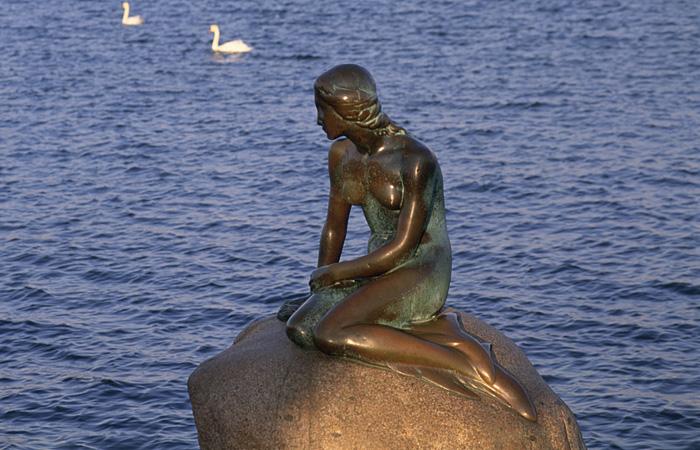
Other areas /
Google Ads
A Look at Three-Dimensional Scandinavian ArtEach Nordic country has its own set of bronze heroes, reflecting its history and culture. |
SUBSCRIBE SEND AS EMAIL |

|
|
|
H. C. Andersen’s little mermaid. She is tiny, only about four feet high. Even so she is a great national symbol, comparable to the Eiffel Tower or the Statue of Liberty.
|
1 2 3 4 5 6 |
|
From extensive travel and a propensity for photographing statues and sculptures, I have accumulated quite a portfolio of Scandinavian three-dimensional art. Each country, as expected, has its own set of bronze heroes, reflecting its history and culture. Iceland, appropriately, puts Leif Eriksson on a pedestal; Sweden, with Charles Xll pointing a commanding finger in the direction of Russia, still dreams of a supposedly more glorious past; Finland, after some 80 years, hears the world applauding as Paavo Nurmi, now frozen in action, wins his ninth gold medal in the Olympics.
As my artist wife likes to point out, most of what you see is “figurative”—statues of any number of kings, often equestrian, and other human figures. But there’s also a contemporary edge to sculpture in Scandinavia, commensurate with its prominence in the world of modern design. Walking around in Copenhagen last summer, I noted a spider-like iron contraption hovering over most of a city square. Another startling sculpture stood in the nearby Rådhuspladsen: a 40-foot high bicycle, wrapped up in green leaves like a Maypole. On Strøget, a third piece of imaginative plastic art caught my attention—a flesh-colored chair, shaped like a woman, complete with protruding breasts. Not surprisingly, Scandinavia excels in remarkable sculpture gardens. Millesgården, outside Stockholm immediately comes to mind. And then there’s the Vigeland Sculpture Park in Oslo. The latter may be the most outrageous and fun. One hundred and twenty-one intertwined figures crawling up a 46-foot tall “monolith.” How can you beat that? And all those surrounding figures in strange poses, and with visitors, especially children, interacting with them? Three-dimensional art is a pretty broad concept so, as long as they’re in the true Scandinavian spirit, why not include an African-inspired glass warrior, or an edible sculpture? H. C. Andersen’s little mermaid. The story of H. C. Andersen’s little mermaid begins in 1909, when Denmark’s big-time brewer and philanthropist, Carl Jacobsen (of Carlsberg fame) saw celebrated ballet dancer Ellen Price in Henriques’ ballet “The Little Mermaid.” Overwhelmed by her performance, Jacobsen persuaded the ballerina to pose for sculptor Edward Eriksen. She posed—but only from the neck up. For the rest of the body, Eriksen’s wife had to step in. A few years later, The Little Mermaid sculpture was installed on a granite boulder in the harbor just north of central Copenhagen. Now, more than a million people visit her every year. But like in Andersen’s sad tale, the life of The Little Mermaid has been far from easy. Her arms were cut off by vandals once, and twice, in 1964 and 1998, she lost her head. Fortunately, the original mold exists, so it has always been possible to recast the bronze and weld back any missing body parts. An abundance of poses Some crawl, others have their legs up in the air. One little boy is stomping his feet and screaming. They are old and young, thin and chubby. They are all part of what their creator, the Norwegian sculptor Gustav Vigeland, titled the “Cycle of Life,” and can be found in the Vigeland Sculpture Park in Oslo. Watching the visitors interact with these groups in granite is part of the fun. Children, especially, add a whole new dimension to the park. The sky is the limit Many of the works of Carl Milles (1875-1955), Sweden’s perhaps most famous sculptor, depict man’s yearning for freedom, for breaking boundaries. Here, in the “Hand of God,” man is lifted to heaven. This is one of the many sculptures that can be seen in Millesgården, the villa and sculpture garden just outside Stockholm (the original bronze cast is in downtown Detroit – not far from Cranbrook, Michigan, where Milles worked for 21 years). The Swedish troubadour In songs written over a lifetime, Ewert Taube (1890-1976) sang of his adventures as a young sailor, of the simple but joyous life in the archipelago, and, with more heart and soul than anyone, expressed the love all Swedes have for the Swedish summer. Here in a statue, overlooking Lake Mälaren and City Hall, the old troubadour makes an expansive gesture as if to embrace the shimmering waters surrounding Stockholm’s Old Town. Nude Nurmi: the flying Finn Taking artistic license, Sculptor Wäinö Aaltonen gave dynamic smooth to the movement of Paavo Nurmi, Finland’s legendary long-distance champion of the twenties. Instead of having his hero race the way he did, using the entire length of his soles, Aaltonen made him run lightly on his toes. He also portrayed Nurmi in the nude, a concession to the neoclassical style of the day. In all, Aaltonen made five full-length bronze casts, four of which are placed in various places in Finland. This one, appropriately, is situated in front of the Helsinki Olympic Stadium. The ultimate peace symbol The refreshingly unusable 45-caliber revolver was photographed near the railroad station in Malmö, Sweden. Also on view at the United Nations in New York City, it was created in 1980 as a peace symbol by the Swedish artist Karl Fredrik Reuterswärd. |
Other articles on Art / Bedroom politics a century ago When Claude Monet Did Norway Mirror of Nature Scandinavian Art in New York Cirkus Cirkör gets under your skin East Meets West Queens kids visit Ribe, Denmark Scandinavian art in New York Immigrant Chefs in America Scandinavian at the International Contemporary Furniture Fair in New York
|
800 827 9333 © Copyright Nordic Reach 2008